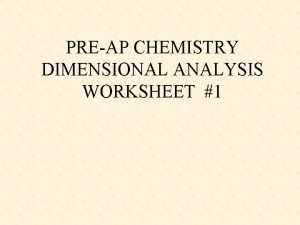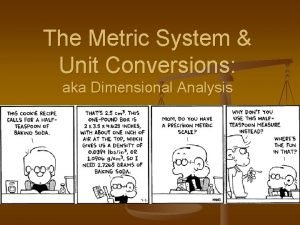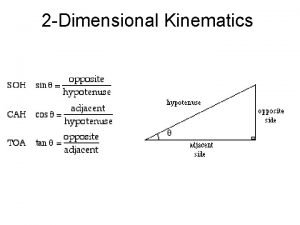Dimensional Analysis How does dimensional analysis work It













- Slides: 13

Dimensional Analysis • How does dimensional analysis work? • It will involve some easy math (Multiplication & Division) • In order to perform any conversion, you need a conversion factor. • Conversion factors are made from any two terms that describe the same or equivalent “amounts” of what we are interested in. For example, we know that: 1 inch = 2. 54 centimeters 1 dozen = 12

Conversion Factors • So, conversion factors are nothing more than equalities or ratios that equal to each other. In “math-talk” they are equal to one. • In mathematics, the expression to the left of the equal sign is equal to the expression to the right. They are equal expressions. • For Example 12 inches = 1 foot Written as an “equality” or “ratio” it looks like =1 or =1

Conversion Factors or Hey! These look like fractions! • Conversion Factors look a lot like fractions, but they are not! • The critical thing to note is that the units behave like numbers do when you multiply fractions. That is, the inches (or foot) on top and the inches (or foot) on the bottom cancel out. Just like in algebra, Yippee!!

Example Problem #1 • How many feet are in 60 inches? Solve using dimensional analysis. • All dimensional analysis problems are set up the same way. They follow this same pattern: What units you have x What units you want What units you have The number & units you start with The conversion factor (The equality that looks like a fraction) = What units you want The units you want to end with

Example Problem #1 (cont) • You need a conversion factor. Something that will change inches into feet. • Remember 12 inches = 1 foot Written as an “equality” or “ratio” it looks like 60 inches x = 5 feet (Mathematically all you do is: 60 x 1 12 = 5) What units you have x What units you want What units you have = What units you want

Example Problem #1 (cont) • The previous problem can also be written to look like this: • 60 inches 1 foot = 5 feet 12 inches • This format is more visually integrated, more bridge like, and is more appropriate for working with factors. In this format, the horizontal bar means “divide, ” and the vertical bars mean “multiply”.

Dimensional Analysis • The hardest part about dimensional analysis is knowing which conversion factors to use. • Some are obvious, like 12 inches = 1 foot, while others are not. Like how many feet are in a mile.

Example Problem #2 • You need to put gas in the car. Let's assume that gasoline costs $3. 35 per gallon and you've got a twenty dollar bill. How many gallons of gas can you get with that twenty? Try it! • $ 20. 00 1 gallon = 5. 97 gallons $ 3. 35 (Mathematically all you do is: 20 x 1 3. 35 = 5. 97)

Example Problem #3 • What if you had wanted to know not how many gallons you could get, but how many miles you could drive assuming your car gets 24 miles a gallon? Let's try building from the previous problem. You know you have 5. 97 gallons in the tank. Try it! • 5. 97 gallons 24 miles = 143. 28 miles 1 gallon (Mathematically all you do is: 5. 97 x 24 1 = 143. 28)

Example Problem #3 • There's another way to do the previous two problems. Instead of chopping it up into separate pieces, build it as one problem. Not all problems lend themselves to working them this way but many of them do. It's a nice, elegant way to minimize the number of calculations you have to do. Let's reintroduce the problem.

Example Problem #3 (cont) • You have a twenty dollar bill and you need to get gas for your car. If gas is $3. 35 a gallon and your car gets 24 miles per gallon, how many miles will you be able to drive your car on twenty dollars? Try it! • $ 20. 00 1 gallon 24 miles $ 3. 35 1 gallon = 143. 28 miles (Mathematically all you do is: 20 x 1 3. 35 x 24 1 = 143. 28 )

Example Problem #4 • Try this expanded version of the previous problem. • You have a twenty dollar bill and you need to get gas for your car. Gas currently costs $3. 35 a gallon and your car averages 24 miles a gallon. If you drive, on average, 7. 1 miles a day, how many weeks will you be able to drive on a twenty dollar fill-up?

Example Problem #4 (cont) • $ 20. 00 1 gallon 24 miles 1 day $ 3. 35 1 week 1 gallon 7. 1 miles 7 days = 2. 88 weeks (Mathematically : 20 x 1 3. 35 x 24 1 x 1 7 = 2. 88 )
 Circular motion is one dimensional or two dimensional
Circular motion is one dimensional or two dimensional Dimensional analysis worksheet 2
Dimensional analysis worksheet 2 Ap chemistry dimensional analysis worksheet
Ap chemistry dimensional analysis worksheet Dopamine drip calculation
Dopamine drip calculation Dosage calculation dimensional analysis
Dosage calculation dimensional analysis Dimensional analysis formula
Dimensional analysis formula Dimensional analysis
Dimensional analysis Dollar bill
Dollar bill Conantucki island
Conantucki island Dimensional analysis grams to moles
Dimensional analysis grams to moles What are two dimensional analysis of objectives
What are two dimensional analysis of objectives Dimensional analysis metric system
Dimensional analysis metric system What is similitude
What is similitude Dimensional analysis definition math
Dimensional analysis definition math





















